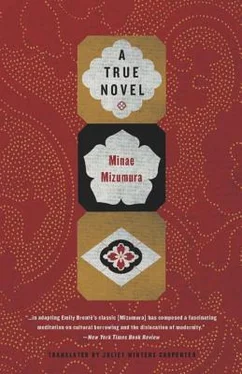Minae Mizumura - A True Novel
Здесь есть возможность читать онлайн «Minae Mizumura - A True Novel» весь текст электронной книги совершенно бесплатно (целиком полную версию без сокращений). В некоторых случаях можно слушать аудио, скачать через торрент в формате fb2 и присутствует краткое содержание. Год выпуска: 2013, Издательство: Other Press, Жанр: Современная проза, на английском языке. Описание произведения, (предисловие) а так же отзывы посетителей доступны на портале библиотеки ЛибКат.
- Название:A True Novel
- Автор:
- Издательство:Other Press
- Жанр:
- Год:2013
- ISBN:нет данных
- Рейтинг книги:4 / 5. Голосов: 1
-
Избранное:Добавить в избранное
- Отзывы:
-
Ваша оценка:
- 80
- 1
- 2
- 3
- 4
- 5
A True Novel: краткое содержание, описание и аннотация
Предлагаем к чтению аннотацию, описание, краткое содержание или предисловие (зависит от того, что написал сам автор книги «A True Novel»). Если вы не нашли необходимую информацию о книге — напишите в комментариях, мы постараемся отыскать её.
A True Novel
The winner of Japan’s prestigious Yomiuri Literature Prize, Mizumura has written a beautiful novel, with love at its core, that reveals, above all, the power of storytelling.
A True Novel — читать онлайн бесплатно полную книгу (весь текст) целиком
Ниже представлен текст книги, разбитый по страницам. Система сохранения места последней прочитанной страницы, позволяет с удобством читать онлайн бесплатно книгу «A True Novel», без необходимости каждый раз заново искать на чём Вы остановились. Поставьте закладку, и сможете в любой момент перейти на страницу, на которой закончили чтение.
Интервал:
Закладка:
Under these circumstances, what happened in fall 1986, a few months after that evening when Yoko sang the lullaby, was hardly a surprise. Taro bought an old mansion in America, and plans for its reconstruction and landscaping were naturally entrusted to Masayuki’s architectural firm. The mansion was situated on an inlet on the north shore of Long Island, near Manhattan. It was a grand but dilapidated Romanesque-style residence known as Windrush, built early in the twentieth century by a millionaire—American nouveau riche, Taro said—who hired artisans from Italy for the task, even importing Italian marble. When Taro heard that Windrush was available, he talked it over with Yoko, and she talked it over with Masayuki, and Masayuki flew all the way to New York to have a look at the place, and Taro decided to buy it. I gather that Windrush was a place well and truly shut off from the world, situated so that you could get a full view of it only from the sea at the end of the inlet. The mansion itself was of course sprawling, and the sadly neglected grounds, with cypress trees from Italy that had withered and died, were large enough to get lost in.
“Even if we three live there, it’s so big that Masayuki and Taro will never have to meet, so we can live there in our old age,” Yoko said. It would be like retiring to a monastery, she told me, half joking and half serious, after she heard Masayuki’s description. “You could come and spend your old age there too, Fumiko.”
“What would I do in a place like that?”
Yoko grinned. “Why, praise the beauty of God’s kingdom,” she said—a mocking reference to her mother’s one-time flirtation with religion. Then, serious again, she stared off at something distant. “Our Karuizawa house is like a gatekeeper’s lodge, he says.”
One reason for picking out an old mansion like Windrush was that Masayuki had always said he would rather tinker with the design of an old place than come up with a new design of his own.
Once the purchase was concluded, their planning picked up speed. Yoko knew nothing about the tea ceremony, but she declared, “I want a Japanese teahouse where I can invite Americans. Then I can get Grandma’s hanging scrolls and incense burners out of storage and use them.” So they decided to uproot a teahouse in Japan and reconstruct it there. Then, in order to include a building of Masayuki’s own design, they also decided to put up a small outbuilding on a promontory on the inlet.
The scale of the project was unimaginably lavish, not just to me but to the three of them as well. Once the decision to buy was made, things moved quickly, but the project, including landscaping, took a full three years and was not finished until just before Yoko died, done in collaboration with an architectural design firm in New York that specialized in the restoration of historic buildings. Masayuki went several times to oversee it in person. He and Taro, who never saw each other after they grew up, exchanged a stream of faxes. They were all swept up in a carnival mood: every possible idea was tossed around, with Masayuki making sketches and architectural models, and Yoko, supposedly as interior designer, sticking in her comments. Looking back, I think that might have been when the three were at their happiest.
WHEN DID IT all start to come apart? That is something I do not know, but I suppose it comes down to our inability, our human inability to make time stand still. As someone who bears direct responsibility for Yoko’s death, I know I have no right to entertain such thoughts. Yet I cannot get over the feeling that time itself was unwilling to allow the happiness of those three to go on.
THE FIRST SIGN might have come when the Saegusa sisters caught on to their three-sided relationship. Because she had her daughter, Miki, to consider, even Yoko actually exercised some caution, which may be one reason why the relationship stayed hidden for so long. Not that the sisters weren’t suspicious. Probably when they learned that Taro had bought the Oiwake cottage, the idea that he and Yoko might be together again had already cropped up in their minds. After I moved to Tokyo their suspicions must have deepened, without going beyond the realm of suspicion. Then, early in 1990, just at the start of the new year, twice in a row the sisters happened to catch Taro and Yoko together. Both times it happened in Shibuya’s Tokyu complex of buildings.
Fuyue told me about it later. The first time, the three sisters had gone to Bunkamura Orchard Hall to see a ballet or something. After the show they went to the basement for a late supper at Les Deux Magots cafe, paid the bill, and were just going through the glass doors when, lo and behold, there they were, the two of them, Yoko and Taro, riding down the escalator. The Bunkamura basement is a stylish place with a distinctive interior. There is a large open space with a big long escalator, twice as long as most, so you can’t help seeing who is on it. Yoko and Taro spotted the three sisters at the same moment that they themselves were seen, but they couldn’t very well jump off midway. They simply rode on down to the bottom and nodded in greeting before disappearing somewhere, away from prying eyes.
Even greater than the sisters’ surprise at catching the two of them together had been their shock at how impressive Taro looked, dressed in a classic black suit. They gaped, unable to take their eyes off him. To put it in Fuyue’s words, he looked like “a prince from another planet” who had just arrived on earth. All the way home in the taxicab, Harue was out of sorts, and the reason was plain. Even earlier, she must have considered my working for Taro as showing a want of respect for the Utagawas, and now she had plain evidence that Yoko was involved with him again—and this when she was married to Masayuki. At the same time, I wouldn’t be at all surprised if in her heart of hearts Harue found it hard to forgive Taro for turning into such a fine-looking man.
The next day, Natsue waited till Masayuki had gone to work and then, apparently put up to it by Harue the night before, telephoned Yoko and started making the usual fuss: “What did you think you were doing? Just who do you think you are, young lady?”
Yoko quickly cut her off. “Mother, it’s our business.”
“What if Masayuki finds out? Then what will you do?”
“When I say ‘our’ business, that includes Masayuki. He knows all about last night.”
Natsue didn’t know what to say. Yoko repeated, “Honestly, it’s our business,” then added, “ ’Bye, Mother,” and hung up. When Harue heard about this conversation, she turned pale and never referred to it again. But less than a week later, the three of them ran into Taro and Yoko in Shibuya again.
This time it happened at the Salvatore Ferragamo shop in the Tokyu department store itself. When the three sisters went inside, they caught sight of Yoko and Taro looking at neckties, and they immediately turned around and left. The next day when Yoko came to Seijo to look after Grampy, Harue glared at her but said nothing. Since she herself had had a lover—her art teacher in New York—she was in no position to criticize anyone on moral grounds, even privately. Only when Yoko came to say goodbye did she let her know that they knew: “Last night you were out with that boy Taro again, weren’t you? We went to Ferragamo too.”
Whether or not it was an act, Yoko answered in the most ordinary way imaginable: “Yes, we were looking for a birthday present for Masayuki. It’s almost his birthday, you know.” Afterward Harue was apparently fit to be tied, ready to explode with anger. This all happened while Yoko’s mother-in-law, Yayoi, was in the hospital after being hit by a bicycle at New Year’s—which was just as well, actually, or Harue might have said something indiscreet. Even then, Yayoi was the sort of person to mull things over in the privacy of her own thoughts and would never have said anything to Masayuki, of that I’m certain.
Читать дальшеИнтервал:
Закладка:
Похожие книги на «A True Novel»
Представляем Вашему вниманию похожие книги на «A True Novel» списком для выбора. Мы отобрали схожую по названию и смыслу литературу в надежде предоставить читателям больше вариантов отыскать новые, интересные, ещё непрочитанные произведения.
Обсуждение, отзывы о книге «A True Novel» и просто собственные мнения читателей. Оставьте ваши комментарии, напишите, что Вы думаете о произведении, его смысле или главных героях. Укажите что конкретно понравилось, а что нет, и почему Вы так считаете.












